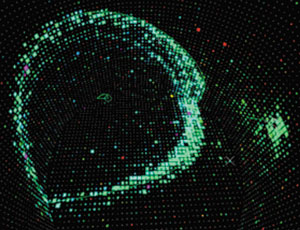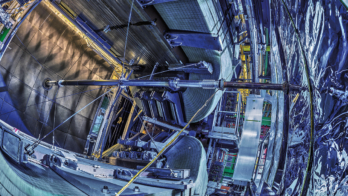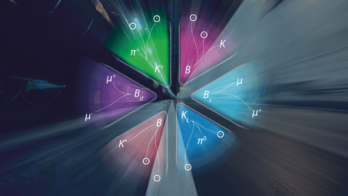
Announced at the recent Neutrino 2000 meeting in Sudbury, Canada, were the first results from the K2K long-distance neutrino beam experiment in Japan. For the first time, synthetic neutrinos made in a physics laboratory are seen to disappear.
In the K2K study, neutrinos (of the muon-like variety) generated at the Japanese KEK laboratory are directed towards the Superkamiokande underground detector 250 km away. In the detector, 22.5 kT of water are monitored by sensitive photomultipliers to pick up the tiny flashes of light produced by particle interactions.
The experiment, which began running last year, was able to announce at Sudbury that 17 neutrino counts had been picked up. The pulses of parent protons at the source accelerator can be used to clock the arrival of the neutrinos, so the results are essentially free of spurious background.
About 29 neutrino counts were expected, assuming the neutrinos despatched from the KEK laboratory arrived unscathed at Superkamiokande. Such a deficiency, if it continues to be seen, implies that something happens to the particles along their 250 km flight path.
This is not a surprise. In 1998, initial results from Superkamiokande on muon signals generated by neutrinos produced via cosmic-ray collisions in the atmosphere showed that the signal from muon-like neutrinos arriving from the atmosphere directly above the detector was very different from the signal arriving from below.
This is not a result of absorption in the Earth – 99.9999…% of neutrinos pass through the Earth as though it were not there. The effect was interpreted as neutrino metamorphosis – “oscillations” – as the particles passed through the planet.
Neutrinos come in three varieties – electron, muon and tau – according to the particles that they are associated with. For a long time, physicists thought that these neutrino allegiances were immutable – a neutrino produced in an electron environment could remain an electron-like neutrino for ever.
However, this is only so if the neutrinos have no mass and travel at the speed of light. If the particles do have a tiny mass, they can, in principle, switch their electron/muon/tau allegiance en route. The 1998 atmospheric neutrino effects seen in Superkamiokande provided the first firm evidence for such neutrino oscillations. These Superkamiokande data have now been consolidated, while other evidence has also appeared.
With neutrino oscillations, neutrinos of a certain type are more likely to change into neutrinos of another type than to interact with matter. If the viewing detector is sensitive only to neutrinos of a certain type, then some neutrinos disappear from view.
Such neutrino disappearance also correlates with the long-observed dearth of neutrino signals from the Sun, where measurements using a variety of detectors (including Superkamiokande) give only a fraction of the number of expected electron-type solar neutrinos. The Superkamiokande detector is sensitive to electron-like and muon-like neutrinos. However, if the parent KEK muon-like neutrinos change into tau-like neutrinos, Superkamiokande would not see them. This is the interpretation of the initial deficiency logged by the experiment in Japan. However, these are only the first results to appear from the K2K experiment, and it usually takes a long time to assemble reliable neutrino data.
The transmutation of muon-like into tau-like neutrinos is good news for long-distance neutrino experiments now under construction. The MINOS experiment in the US will send neutrinos 730 km from Fermilab to a detector in the Soudan mine, Minnesota, while neutrinos from CERN will be despatched towards new detectors in the Italian Gran Sasso underground laboratory, also 730 km distant. The detectors in these projects hope to pick up signs of tau-like neutrinos not present when the beams left the parent laboratories.
Because of the scant affinity of neutrinos for matter, intercepting them in a detector is always a challenge. The DONUT experiment at Fermilab recently presented possible evidence for the production of tau-like neutrinos in particle interactions.
The K2K experiment is a collaboration involving Japan, Korea and the US.





